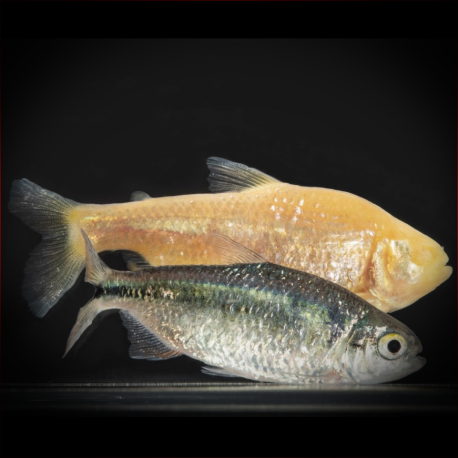More info
Datasheet
| Minimum Tank Size | 72 litres / 19.02 US gallons |
| Maximum Size | 9.5cm / 3.74inches |
| Temperature | 20°C / 68.00°F - 25°C / 77.00°F |
| Hardness | 5.04dgH / 90ppm - 25.04dgH / 447ppm |
| pH | 6.5-8.0 |
General Description
The Blind Cave Tetra, scientifically known as Astyanax Mexicanus, belongs to the family Characidae and falls under the classification order Characiformes. This species exhibits an intriguing adaptation, with the eyeless, troglomorphic form found exclusively in Mexico. The blind form has lost its eyes and much of its pigment, possibly to enhance other sensory areas such as taste receptors on the head. The fish relies on its lateral line to detect water pressure changes and navigate its surroundings. It is a popular choice for aquarists due to its unique characteristics and ease of care in community tanks.
Aquarium Setup
The Blind Cave Tetra, reaching a maximum size of 9.5cm, requires a minimum tank size of 72 litres. Being blind, this species does not necessitate specific decorations or cover in the aquarium. While plants are not essential since they are absent from its natural habitat, setting up a cave-style tank with rocks, slate pieces, and a dark substrate can simulate its underground environment. Dim lighting, such as red or blue light tubes, can enhance the aesthetics of the setup (see table for water parameters).
Behaviour
This tetra species is incredibly hardy and peaceful, making it an ideal choice for beginners and suitable for most community aquariums. However, it may display some nipping behavior towards tankmates during feeding, primarily due to its unique searching technique rather than aggression. While not gregarious, keeping at least four individuals in a group is recommended for optimal well-being. The Blind Cave Tetra can become more active when placed in unfamiliar environments as it uses its lateral line to map its surroundings quickly.
Feeding and Diet
In captivity, the diet of the Blind Cave Tetra should consist of high-quality dried foods supplemented with small live and frozen options. Offering a variety of foods ensures the fish receives essential nutrients for its well-being. These tetras are known to be prolific feeders and will readily accept a diverse diet, contributing to their overall health and vibrancy in the aquarium setting.
Reproduction & Dimorphism
Breeding the Blind Cave Tetra can be achieved with relative ease by meeting specific requirements. Conditioning the sexes separately, providing a suitable environment for spawning, and removing the adults once eggs are laid are crucial steps in successful breeding. Females typically appear larger and fuller-bodied, especially when carrying eggs. The fry, which hatch within 24 hours and become free-swimming after 5-7 days, require specialized microscopic food initially before transitioning to larger items in their diet.
Habitat and Distribution
The Blind Cave Tetra's distribution ranges from the southern United States, particularly Texas and New Mexico, through Mexico, and into Guatemala. While the surface-dwelling form inhabits various aquatic environments like streams, rivers, ponds, and lakes, the blind form is exclusive to underground caves and caverns. This species' widespread presence underscores its adaptability to diverse habitats within its native range.

